Innumerable creative inputs can be identified in recounting the cultural proposals of Arte al Centro, a series of exhibitions inaugurated yesterday, 25 June, in the spaces of Fondazione Pistoletto. Yet, with a subjective look, I would first like to dwell on what is not usually a primary aspect in the narration of an event, but is in fact of absolute importance: the public. Yes, because the people present, despite being a generational and geographical plurality, were united by one condition, one state of mind: astonishment, which is the sense of disbelief and disorientation caused by something unexpected. This might be a jarring concept when associated with Cittadellarte and its best practices and projects with sustainable and innovative themes: one would not be surprised to see something extraordinary at Fondazione Pistoletto. And yet, when one passes the threshold of the exceptional by crossing the boundaries of wonder, an emotional spark is naturally and suddenly ignited. The astonishment could be clearly perceived: it could be heard in the whispers among the almost 2000 people present, it could be scrutinised in facial expressions, it could even be noticed in non-verbal communication. Each exhibition, each performance, each work, each activity, in its own way, enriched and made the event unique. Arte al Centro was also special in terms of anniversaries: its 25th edition, the 20th anniversary of the birth of the Third Paradise and, above all, Michelangelo Pistoletto‘s 90th birthday. The artist himself was the first to generate amazement with his evocative and inspiring words, in the morning during the talk Lo stato dell’arte (The state of art), and in the afternoon during the celebrations, amid applause, and the cutting of the cake in the shape of the Third Paradise. The artist was visibly moved: the hat he wore could not conceal his eyes tearing up at the surprise of a video of greetings that retraced his life in 90 photos, from his birth to his 90th birthday. He probably did not expect such participation and involvement from the city and the entire world, with artists and ambassadors of the Third Paradise coming to Biella not only to take part in Arte al Centro, but also to pay homage to him.

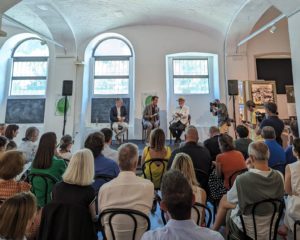
Carlo Grosso, Paolo Naldini and Michelangelo Pistoletto. Photo by L.D.
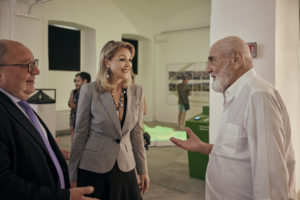
Claudio Corradino, Silvana D’Agostino (Biella’s Prefect) and Michelangelo Pistoletto.
Photo by Damiano Andreotti.
The talk Lo stato dell’arte (The state of art)
The day started in the spaces of Biella Città Arcipelago Demopratico, which was the active backdrop to the talk Lo stato dell’arte. The conference was introduced and moderated by Paolo Naldini, director of Cittadellarte: “Ours is not a single adventure, but a singular one,” he said in reference to the project Biella Città Arcipelago,“here we are in a space dedicated to the objective of working together as a territory and of making our representatives cooperate in harmony with us. If we think of the Third Paradise, we find in the two opposite circles the representatives and the represented, and, in the central circle, this space, which presents the more than 100 subjects with whom we collaborate and the businesses, which are the civic productive fabric of our territory”. Naldini then recalled the thematic working tables that were developed under the direction of the Province, in the figure of Carlo Grosso. “Mine is a complicated role,” Grosso remarked, “because I try to bring things together. In this place, this happens: we see all the excellences of our territory in the panels: industrial, voluntary and social activities. A path built here with a look to the future. And the public side that I represent has responsibilities and must also walk this path, there must be no disconnection between those who administer and those who are administered. Biella Città Arcipelago,” he added, “is an example of an enlightened design that must be exported, because other parts of Italy look at this model with admiration. We must therefore cultivate ambition in our territory”. Michelangelo Pistoletto spoke next: “Something important is shifting in our territory. The first act was to have the whole province, with all the municipalities, agree to support Biella’s candidacy as Creative City. And here we are today: every mayor should offer their own contribution to make the Archipelago City project become total and particular. Indeed, we are at the start of a new course: the city of Biella is an archipelago that must move towards a perfectly balanced composition of nature and artifice, always aiming at sustainability. It is time to move from ideas to practice,” he stressed,“Cittadellarte is a parliament of responsibility in which this process can take shape”.
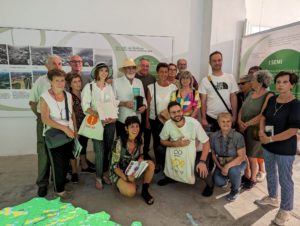
Photo by L.D.
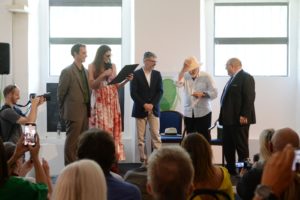
Paolo Naldini, Benedetta Borrione, Carlo Grosso, Michelangelo Pistoletto and Claudio Corradino.
Michelangelo Pistoletto Master of Biella Città Archipelago
At the end of the talk, Paolo Naldini announced a ‘surprise’ for Michelangelo Pistoletto: the title of Master of Biella City Archipelago. For the occasion, a plaque was presented to him by Carlo Grosso and Benedetta Borrione (from Cappellificio Cervo), who read the motivations and donated a hat with the symbol of the Third Paradise in silver to the founder of Cittadellarte with a “Hats off, maestro!”.
Pistoletto then expressed his thanks: “I am moved. This is the highest recognition for me: at 90 years old, someone puts a crown on my head,” he said, laughing, “over time I have understood that the definition of master is important: masters are needed in life, as well as in school. So I accept this title of master, which I would like to pass on to others. Mastery must always be carried on: children cannot be born masters, they must be guided”. Claudio Corradino, the mayor of Biella, also addressed a thought to Pistoletto: “It is always exciting to listen to you and be faced with your greatness. I admire the fact that you do not keep art for yourself, but you make it grow and spread to anybody. I find the concept of archipelago perfectly suited to the Biellese territory”.
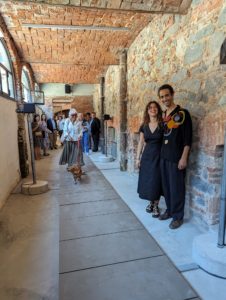
Ginevra Naldini and Marco Isaias Bertoglio. Photo by L.D.

Accademia Unidee Project Room. Photo by Damiano Andreotti.
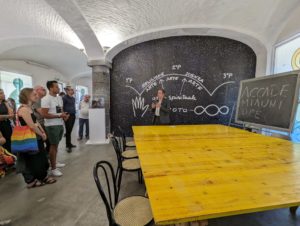
Francesco Monico. Photo by L.D.

Michele Cerruti But. Photo by Accademia Unidee.
Biella Città Archipelago, /pàs.so/, Accademia Unidee’s Project Room and Selfie Inteview
After the talk, the audience went on a discovery tour of the contents of the exhibitions, guided by the saxophone melodies of Accademia Unidee’s student Melissa Jazz, which punctuated the transition from one exhibition/activity to the next. The itinerary started with a visit to the spaces of Biella Città Arcipelago, which also housed the Third Paradise Hologram donated by Tria (3) and the infographic created by information designer Alessia Musìo as part of the Biellese Water Observatory, with an installation dedicated to a conscious use of water, the environmental state of water bodies and the procedures for water analysis. This was followed by the inauguration of a sound installation by Ginevra Naldini and Marco Isaias Bertoglio entitled /pàs-so/, an interactive workshop tool investigating the relationship between body, sound and territory, proposed as part of the Woolscape project. Next was the Universarium, conceived by Michelangelo Pistoletto as a visual atlas of the Formula of Creation, which included the spaces of Accademia Unidee, where students learn how art can be a tool for transforming society and how fashion can be sustainable. The daily life of the academy was presented through videos, in-progress works, experiments and the spaces themselves as one big collective learning workshop. On the occasion of Arte al Centro, the focus was specifically on Accademia Unidee’s Project Room, with a greeting from Accademia’s director Francesco Monico and the presentation of the work of the students of the Socially Engaged Art and Sustainable Fashion Design courses by the academic coordinator Michele Cerruti But, who also explained: “In Biella there is an academy. This is a political act: to have an institute of higher artistic education in the Biella area, within a contemporary art foundation, means building a possibility for growth not only for the territory, but also for the people who pass through it”. Throughout the day, it was also possible to participate in the installation/performance Selfie Interview, part of the programme of Terme Culturali, in which a chair was placed in front of a seated robot and the participant, sitting down, was invited to enter into a dialogue conducted by that robot: the interview covered the salient and significant points of the interviewee’s life, and its video recording was subsequently handed over to the participants themselves, who, through the “selfie interview”, entrusted their soul to the common memory and understanding of others.
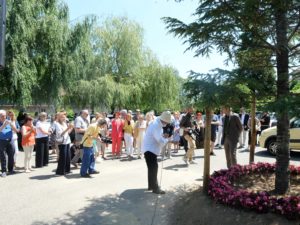
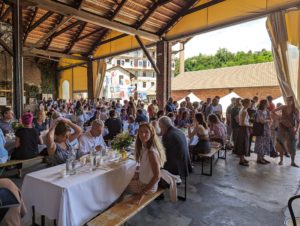
Photo by L.D.
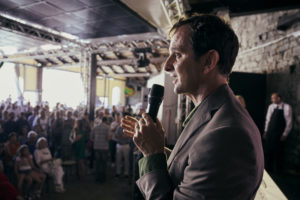
Paolo Naldini. Photo by Damiano Andreotti.
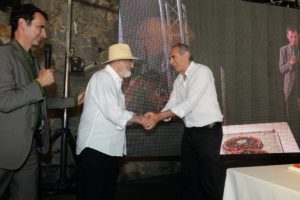
Michelangelo Pistoletto and Carlo Capasa.

Max Casacci and Michelangelo Pistoletto.
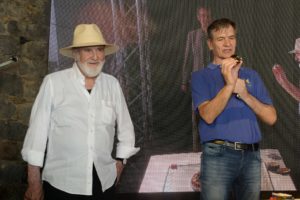
Michelangelo Pistoletto and Paolo Nespoli.
The cedar of Lebanon, lunch and the best wishes to the master
Later in the morning, the spotlight was on the cedar of Lebanon recently planted in the centre of the square in front of the Third Paradise garden. “The tree,” said Pistoletto, “was donated by the members of the Lions Club of Biella on the 30th anniversary of when they awarded me with the Imago Prize in 1992: I had recently acquired the spaces in Via Serralunga and at the ceremony I mentioned the name of Cittadellarte for the first time. This tree, therefore, is reminiscent of the beginning of Cittadellarte as it is about the same age”. This moment was followed by a private lunch, a convivial moment that was an integral part of the day, with the Sale Auliche and the former Concept spaces acting as a theatre for the high-quality cuisine offered by Cittadellarte’s restaurant ‘Al Bistrot le Arti’. Vegetables and bread were provided by Agriturismo la Fucina, Let Eat Bi‘s partner, while the beverages were provided by Acqua Lauretana, Vino Zaccagnini, Birra Menabrea, Natural Boom and Caffè Illy. On top of that, all the participants in the event were offered the Love Difference ice cream – created by Maria Pioppi Pistoletto and prepared by Alice’s ice-cream parlour – based on halva, a sesame paste typical of the Arab countries bordering the Mediterranean.
After indulging in territorial specialities, it was time for the cutting of Michelangelo Pistoletto’s 90th birthday cake. The celebration of the artist’s birthday took place in the former Concept space in the early afternoon, with congratulatory speeches by Cittadellarte’s president Giuliana Setari (“We celebrate the maestro and with him the 25th anniversary of Arte al Centro,” she said, before reading Pistoletto’s text entitled Anno Zero), Max Casaccifrom Subsonica (“Michelangelo, with his Third Paradise, has taught us that we can become adults without necessarily becoming old”), astronaut Paolo Nespoli (“Art and astronomy take us to a different world to be explored, which allows us to look inside ourselves, but also outside. Best wishes, Pistoletto, together we go towards the unknown to understand it more and more”), the president of the National Chamber of Italian Fashion Carlo Capasa (“With the Venus of Rags, Michelangelo was a forerunner of sustainable fashion; I thank him for showing us the way to the future”) and actress and Rebirth/Third Paradise ambassador Elena Guerrini (who intoned a special nursery rhyme dedicated to Pistoletto). The artist then thanked the audience and guests for the emotional messages received (“I feel these greetings as a baptism, not in the religious sense, but as an initiation”). As mentioned, the climax was the film projected on the maxi screen: 90 photos of Michelangelo Pistoletto, one for each year of his life, accompanied by the song Il Terzo Paradiso by Subsonica. This moment of celebration continued with the cutting of the cake (of course in the shape of the trinamic symbol) by Pistoletto himself, who shared it with all those present.


Rebecca Sforzani, Agustina Bottoni, Lucia Chain, Juan Sandoval, Olga Pirazzi and Giorgio Fermanelli.
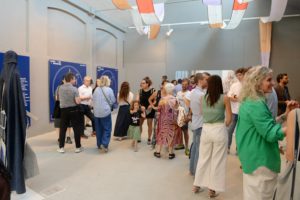

The afternoon with sustainable fashion
The pivotal theme on which a large part of the event was centred was sustainable fashion. The afternoon saw the opening of CirculART 3.0, curated by Fashion B.E.S.T. and UNIDEE Residency Programs in collaboration with Matteo Ward. The third edition of the project involved companies, artists and fashion designers together with Cittadellarte – Fondazione Pistoletto in demonstrating how to explore new forms of productive, design and sharing balance through a careful choice of sustainable materials and supply chains. Three key concepts underpin the circularity of sustainable fashion and this initiative: Reduce – reducing raw material consumption, Reuse – reuse of raw materials, and Recycling – regeneration. The exhibition includes the following projects: Assembly For Regeneration by Agustina Bottoni, a communal space made out of textile materials to reflect on alternative and healthier ways of producing and consuming; ReBeLsTrAnDs (ReB; eLsTr; AnDs) by Huge Sillytoe, which features strips, shreds and splinters of material that refuse to conform to the mechanical processes to which they are attempted to be subjected; Memories of a precipitous future by Lucia Chain, inspired by the imperfect circles created by the motions of water, which the artist visualises as mirages, imagining a future without water and clinging to the memory and nostalgia of a storm in order to survive; Che non siano solo macchinari (May they not be just machines) by Rebecca Sforzani, a reflection on the theme of work, triggered by the observation of a series of historical uniforms and by the interest in connecting past and future, memories and expectations of those who live the world of textiles from the inside (the silhouettes that make up the work, made from the waste materials of the same companies they represent, personify the different figures involved during the process).
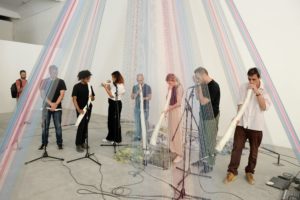
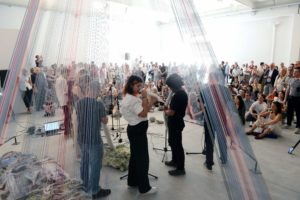
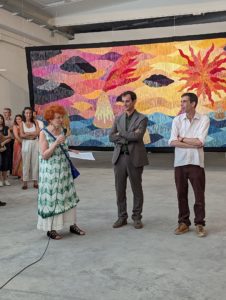
Gabi Scardi, Paolo Naldini and Matteo Nasini. Photo by L.D.
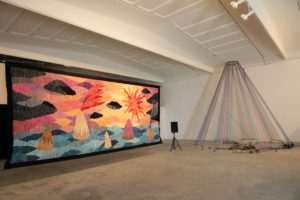
Curator Gabi Scardi then presented Matteo Nasini‘s The Golden Age, part of the project Woolscape, which aims at enhancing the wool culture of the Biella area with the desire to make the place more attractive to both tourists and residents. This installation was conceived specifically for the spaces of Fondazione Pistoletto and consists of a structure of threads stretched to define a sensitive field in relation to a large tapestry. The image represented is a seascape of volcanic character, with cones rising between sea and sky, generating a vision of beauty and wonder. On the day, the installation was accompanied by the sound performance Neolithic Splendour, played using copies of actual animal bones as musical instruments that the artist created inspired by the ancestral world. The sound could be reactivated by visitors throughout the exhibition, and enjoyed thanks to a series of benches made available to them. The visit to the exhibition wanted to inspire a moment of reflection; an occasion in which to activate a proactive, design-oriented thought with respect to the theme of landscape, too often interpreted only as a commodity at our disposal. “The performance,” says Nasini, “reflects on the elements of the origins of music, from the appearance of harmonies to sound as a form of cultural aggregation”.
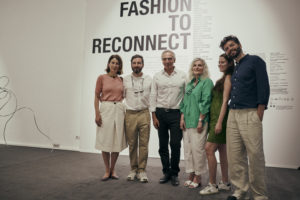
Maria Teresa Pisani, Tiziano Guardini, Carlo Capasa, Olga Pirazzi, Jovana Vukoje and Luigi Ciuffreda.
Photo by Damiano Andreotti.
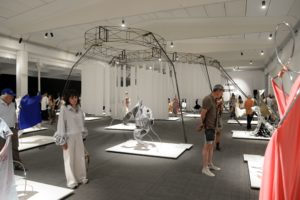
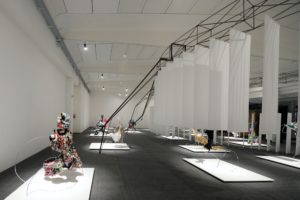
Opening next was the exhibition Fashion to Reconnect, inspired by the new dynamic balance of Michelangelo Pistoletto’s Third Paradise, and featuring clothes and fashion objects as works of art that become a tool to raise awareness for responsible social change. Designers, entrepreneurs, brands and artists reconnected with nature to create a harmonious relationship, where the choice of materials and processes, and the change in perception of creation itself become the driving force behind a virtuous transformation of fashion. The garments – selected by Cittadellarte Fashion B.E.S.T. in collaboration with the National Chamber of Italian Fashion and with the curatorship of Tiziano Guardini – are made as unique pieces and accompanied by a certificate of authenticity just like any work of art.
In Fashion to Reconnect, the designers/artists have become sensitive creators of a new civilisation in which the dialogue between opposites and between different species is at the basis of creation, and invite us on a meditative journey towards clothing as the first home we inhabit, the chosen home in which to feel reconnected. “The Third Paradise,” Guardini said, “is an ancestral symbol that projects itself into the future and finds harmony”. His words were followed by those of Naldini: “We have a way of becoming authors and being less and less automatons. Tiziano and his team have managed to turn even mannequins into authors. Fashion can clean up and regenerate the world and we can wear costumes consistent with our planet”. This area also featured three ad hoc video-installations: the documentary Fashion for Forest (a filmic work starring Oscar-winner Michelle Yeoh shedding light on the development and production processes of a sustainable garment in Tencel™ fibre-cellulose, made with materials from forests), Fashion For Planet Open Parliament (a project by Cittadellarte and Cittadellarte Fashion B.E.S.T. in collaboration with the National Chamber of Italian Fashion, which recounts the civic parliamentary session called by fashion to share testimonies and activate a dialogue with the planet, held in Milan on 27 February and) and Junk – Armadi Pieni (Full closets, a series in which fashion designer Matteo Ward offers an emotionally and journalistically charged cross-section of the fashion world’s long-standing issues in a narrative articulated between Chile, Ghana, Bangladesh, Indonesia, India and Italy).
A Thread for Two
Arte al Centro also featured the exhibition A Thread for Two, proposed in collaboration with the Woolbridge Gallery. The exhibition displays the works Untitled by Ghada Amer and Two Thousands Years Embroidery No. 43 by Zheng Guogu. The former is a yellow canvas embroidered with brown thread, the subject of the work is figurative and expresses the freedom of women in a society where morality is rigidly dictated and imposed through politics. Femininity is portrayed without moralistic modesty: this is how the artist reclaims the naturalness of being and behaviour. The technique used is not that of painting but of sewing: a manual skill that also comes from tradition. The brown embroidery is perfectly completed, but the thread is always interrupted and visibly let to fall free as the design continues with a new thread of the same colour threaded into the needle. It is the meaning of life that changes as it continues. The work Two Thousands Years Embroidery No. 43 analyses the aspects that Western culture and digital technologies assume within Chinese life and its traditions, and consists of a blue canvas with a gold embroidery that makes it look like a tapestry. The gold threads draw precise squares on the blue background, and each one contains one or more messages typical of those used among young Chinese people to understand each other cryptically. The transfer of technology into art through the golden thread of thought is significant of the assumption of personal freedom and social responsibility. The embroidery thread unites these two works with both artistic-sociocultural and sociopolitical meanings.
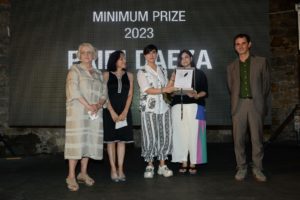
Giuliana Setari, Rossella Ravagli, Pairi Daeza and Paolo Naldini.
The Minimum Prize
This year, once again, Cittadellarte has awarded the Minimum Prize, a prize that is a minimum compared to the maximum prizes awarded to great personalities who have dedicated their lives to the cause of peace or civil progress in the world. The prize – presented by Paolo Naldini, Giuliana Setari and Rossella Ravagli (director of the Sustainable Fashion course at Accademia Unidee in Biella) – was awarded to Pairi Daeza. – These are the motivations for the award as read by Ravagli: “Pairi Daeza means ‘enclosed garden’ in ancient Persian. Persian gardens are so exceptional that the term ‘Pairi Daeza’ has become a loan word and has shaped the concept of paradise in many languages. Pairi Daeza are two Iranian sisters: Yasaman and Nastaran Rezaee. Their vision is ‘to reclaim a suppressed identity and a dying heritage through Iranian art and craftsmanship’. Their mission is ‘to create unique, hybrid and unconventional styles where East meets West and where mysticism merges with practicality. Produced in Italy, where the two sisters now reside, but fuelled by dreams of ancient Persia, the brand’s collections are made in collaboration with small marginalised communities of artisans living in Iran. The aim is to generate economic flows for these artisans by renewing traditional Iranian handicrafts. To the question ‘How do you weave that thread that unites East and West? In order to cross certain bridges, sometimes imposed by borders, you need connections…’ they answered ‘Connection is the essence of human beings, it is a need for freedom, a form of personal expression and an aspect of beauty… it is what led the whole world to rise up alongside Iranian women. We may or may not be connected to each other, but we still feel each other’s pain. We are fortunate enough to be able to enjoy the wonders of Italian culture, Persian heritage has much to offer too, and to let it be lost would mean damaging a wealth that is not only ours, but belongs to the entire world’.
Pairi Daeza recently launched the project Woman Life Freedom, a collection of scarves produced in collaboration with twelve Iranian artists. Each artist has created a unique design, incorporating messages related to the current revolution in Iran, with the hope that these messages will travel across places and keep the conversation about this women-led revolution alive. All profits from the sales of the scarves will go to the Abdorrahman Boroumand Center (www.iranrights.org), to support the movement in Iran. The Minimum Prize 2023 is therefore awarded to Pairi Daeza for their efforts to generate, curate and foster the connection that unites people in society across different sectors and roles, the ‘minimum’ degree of social relationship, and to engage fashion as art at the centre of a responsible transformation of society”. The two sisters’ thanks were heartfelt and hopeful: “Having the time and luxury to think about a sustainable future in the long-term is a privilege not all of us have,” said Nastaran, “my sister and I had a choice and decided to escape the monster (the regime) in Iran, but to show our gratitude for all that Iran had given us, including our values, we started thinking about this project and my sister dedicated years of her life to travelling around Iran in search of the most stifled voices to integrate their art, crafts and stories of resistance into a project whose mission is to help correct the distorted image of Iran. Ironically, those same stifled voices have now forever transformed the image of Iran into a country of brave freedom fighters, raising against oppression and making themselves heard by the world at the cost of their own blood. I am saying this to emphasise that building a sustainable future is a global goal, and as long as half of us live in conditions that do not allow us to see beyond tomorrow, we will never reach the third paradise here on earth. It is therefore our responsibility as privileged people, who have not earned their circumstances by merit, but by birth, to extend hope and future horizons to our other sisters and brothers in the world”.
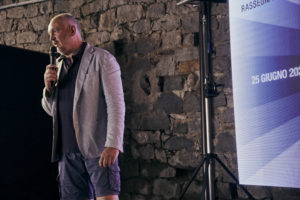
Saverio Teruzzi. Photo by Damiano Andreotti.
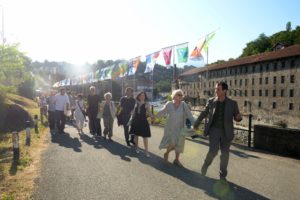
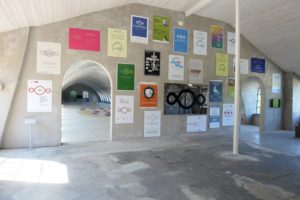
The Third Paradise, between paths and flags
“In addition to sustainable fashion, this edition of the event is also dedicated to the Third Paradise and the Rebirth ambassadors: they do not represent a state, but a concept of the future and sustainability that we all hope for”, this is how Saverio Teruzzi, coordinator of the ambassadors, presented the projects he developed with the embassies: The Flags of the Third Paradise and Sentiero Rebirth / Rebirth Path. The first is an installation curated by Teruzzi himself with the collaboration of Andrea Abate: a series of flags between Cittadellarte and the permanent home of the Third Paradise to represent the ambassadors, who, in the words of Teruzzi, “operate in their territories in over 50 countries around the world as actors of a co-creation of democratic propositional processes through the authorship of doing, developing the art of demopraxia. They are activators of the trinamic formula conceived by Michelangelo Pistoletto, which represents the search for balance and harmony on the basis of dialogue and the concept of preventive peace”. The Third Paradise space also featured Sentiero Rebirth / Rebirth Path, a video installation curated by Teruzzi and Daniele Garella:“From an idea by Michelangelo Pistoletto and the ambassadors of the Third Paradise. One date, 21 March 2023, one action all over the world: joining hands. Many different lines on a single map, a single virtual line around the planet. A global participation, against all monstrosities caused by man. All of them, none excluded”. The collective performance The Path of Preventive Peace was replicated involving those present at Arte al Centro: everyone, united hand in hand, walked towards the Third Paradise forming a human chain as a symbolic manifestation of preventive peace. The permanent home of the Third Paradise is also temporarily accommodating the work by the French-Algerian artist Adel Abdessemed Citizen (2015, graphite on porcelain and wood), which has been placed in the central circle of the formula of creation; the work represents the ball, the sphere of chance, disputed between peace and war.
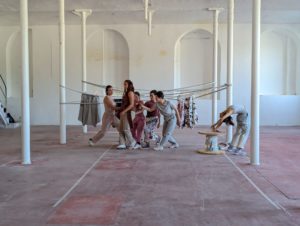
Photo by L.D.
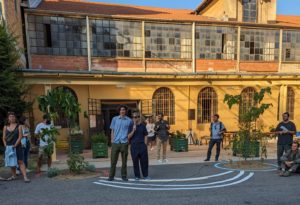
Guerrilla Spam. Photo by L.D.
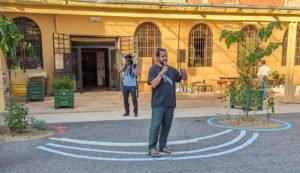
Aaron inker. Photo by L.D.
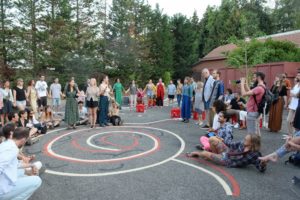
The conclusion with dance, a talk and a performance
Later during the day, the ground floor below the Third Paradise space was the stage for Fashion | Culture | Sustainable | Ethical | Conscious, which saw the young dancers of Pratiche di Slancio interpret Fashion B.E.S.T. in an evocative show (choreographed by Cristiana Valsesia, with the artistic direction of Claudia Squintone and the project management of Eleonora Celano). Afterwards, the new Hydro space hosted the talk Floating Forest: a green space for the city, featuring aaron inker (Nicholas Ferrara) and Guerrilla Spam presenting the new Hydro home – reborn at last after the October 2020 flooding – and the project Floating Forest. The day closed with the performance by BARЯA Movement entitled Caro Cervo. The fluid art collective based in Belgium was invited to take part in a residency to get to know Cittadellarte and produce a new performance work. On this journey, full of meaningful encounters, they were guided by the UNIDEE Residency Programs team. Their practice is rooted in regenerative art, which focuses on processes of creation restored and revitalised by art itself. Their work Caro Cervo was an open invitation to the whole of Cittadellarte, a collective performance that aimed at triggering a process of deeper relationship with each other and with the river Cervo. Two weeks before Arte Al Centro, BARЯA Movement invited those who work and ‘live’ at Cittadellarte to collect and ‘look after’ one of the stones laid by the collective on the courtyard inside the Foundation. These stones – chosen by drawing inspiration from a sound recording of the stream bank – acted as a bridge between people and the Cervo, thus creating a link between man and nature while at the same time giving voice to the river. The performance was collective but proved to be intimate, profound and introspective: Arte al Centro closed with an inspiring look at the bond and relationship between the individual, society and nature, amidst smiles, emotions, handshakes, hugs and an explosive energy that first started with Michelangelo Pistoletto and then spread like wildfire through the art and creativity of everyone, including the public.

